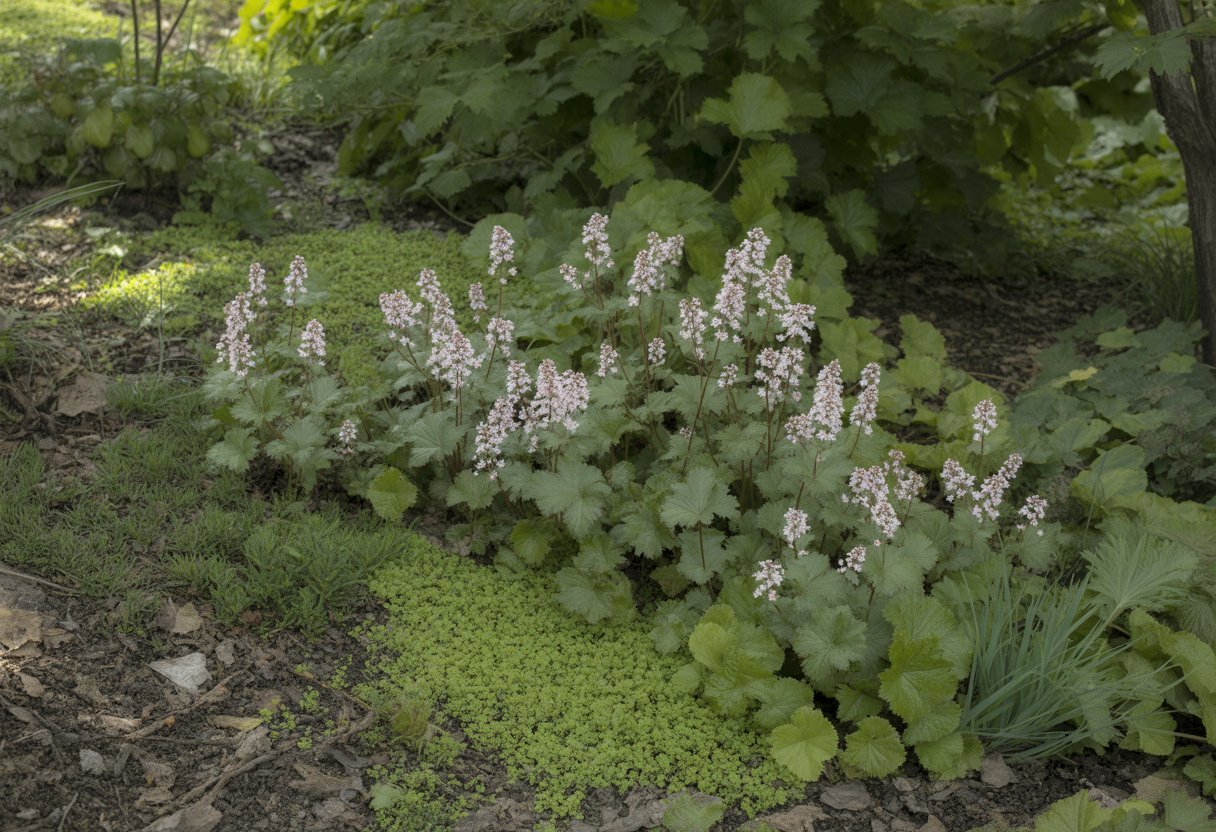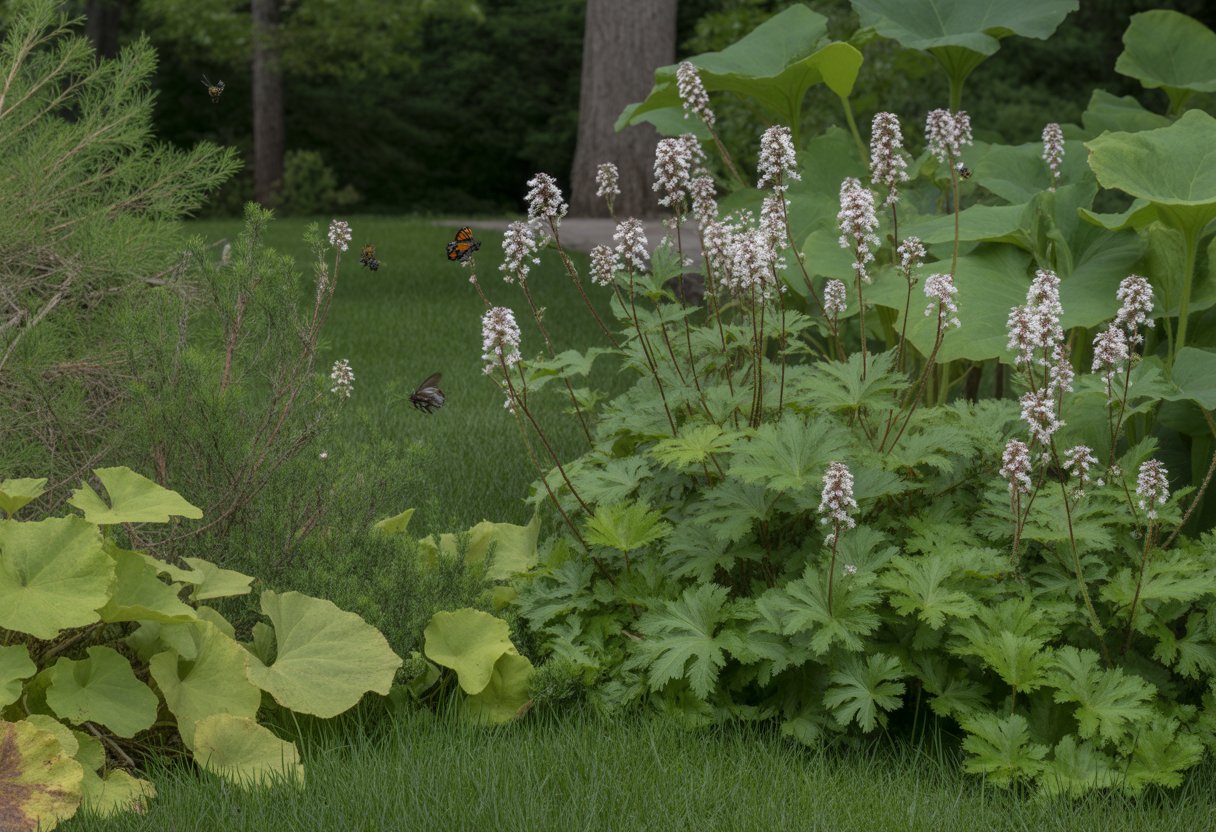Landscaping with Native Foamflower in Missouri: Enhancing Shade Gardens Naturally
Native foamflower (Tiarella cordifolia) is a versatile and attractive groundcover that fits right in with Missouri landscaping. It thrives in shaded, moist spots like the region’s woodlands, so it’s a natural pick for anyone looking to create a relaxed, naturalistic garden.

You barely have to fuss over it, and it supports local ecosystems. In spring, foamflower adds delicate white blooms that brighten up gardens without needing fertilizers or pesticides.
Its spreading habit helps control erosion and keeps things interesting year-round with its unique foliage. Homeowners and landscapers who want sustainable, low-maintenance solutions often pick native foamflower for its adaptability and ecological benefits.
If you know how to work this plant into your yard, you can end up with a healthier landscape that actually fits Missouri’s environment.
Understanding Native Foamflower in Missouri
Native foamflower is a shade-loving perennial that does especially well in Missouri’s woodlands. Gardeners value it for its delicate white blooms and its knack for thriving in those tricky understory spots.
Botanical Characteristics of tiarella cordifolia
Tiarella cordifolia, or just foamflower, stays low to the ground and spreads slowly. It usually grows 6 to 12 inches tall and spreads by rhizomes, so it forms a thick, green carpet over time.
Its heart-shaped leaves can show off silvery or reddish markings, which look great even when it’s not in bloom. In summer, foamflower sends up airy white or pale pink flower spikes that float above the foliage, kind of like clusters of foam bubbles.
These blooms rise on slender stalks, giving the plant a light, delicate look. Foamflower definitely prefers moist, well-drained soils, so it works best in shaded beds or woodland spots.
Ecological Benefits of Foamflower
Foamflower helps native ecosystems by providing early-season nectar for pollinators like bees and butterflies. Its dense leaves offer shelter for insects and small critters at ground level.
Because it’s a native plant, foamflower holds soil in place and supports biodiversity without needing fertilizer or pesticides. Its spreading rhizomes make it tough for invasive species to get a foothold.
Regional Distribution and Habitat Preferences
You’ll find Tiarella cordifolia all over Missouri, especially in shaded, deciduous forests and along stream banks. It likes spots with steady moisture and rich, well-drained soil.
The Ozark region is a real hotspot, thanks to its forest understories and moist soils. If you want to mimic natural Missouri habitats, foamflower’s resilience makes it a smart addition for shaded gardens.
Designing Missouri Landscapes with Foamflower

Foamflower feels right at home in Missouri’s native gardens. It brings year-round interest and real ecological perks, plus it’s flexible enough to work as groundcover, a companion to other plants, and a wildlife magnet.
Incorporating Foamflower as Groundcover
Foamflower (Tiarella cordifolia) works wonders as a groundcover in Missouri’s shady gardens. It forms dense mats that keep weeds down and help the soil hold onto moisture.
Plant it in partial to full shade, in well-drained, humus-rich soil. Over time, it’ll spread slowly, making a soft carpet under trees like redbud and dogwood.
There’s not much maintenance—just trim off dead leaves in early spring to keep things tidy. Its textured leaves play nicely with hosta and ferns, adding depth and a little pop to shady spots.
Combining Foamflower with Companion Plants
Foamflower pairs up well with other natives like wild ginger, columbine (Aquilegia), and blue lobelia. These companions stagger their blooms, so your garden stays lively and colorful.
Try mixing in woodland phlox (Phlox divaricata), wild geranium, or bleeding heart (Dicentra) for even more variety. Their flowers bring in pollinators and keep things interesting.
If you want some contrast, add in mahonia or spicebush for evergreen texture. This way, your garden looks good all year and supports a wider range of wildlife.
Garden Design for Shade and Woodland Areas
Foamflower adapts easily to Missouri’s woodland settings, especially under native trees like dogwood and redbud. It thrives in moist, slightly acidic soils you often find in these areas.
Use foamflower to create gentle ground layers beneath taller plants like ferns and bee balm. Its soft green leaves brighten up shady corners without stealing the show.
Avoid planting it in spots that get too dry or where the soil is packed down. Grouping foamflower with trees and shrubs that boost soil moisture helps it stay healthy.
Creating Wildlife Habitat Using Native Flora
Foamflower supports local wildlife by offering cover and attracting pollinators like bees and butterflies. Adding it to native gardens encourages biodiversity and helps wildlife thrive.
Pair foamflower with nectar-rich plants like black-eyed Susan, coreopsis, and blazing star to feed pollinators. Toss in buttonbush and Virginia bluebells to make your habitat even more inviting.
Its low growth provides shelter for ground-dwelling insects and small amphibians. With some thought, you can help create resilient corridors for wildlife, even in suburban yards.
Cultivation and Care of Foamflower
Foamflower does best when you give it conditions similar to its natural woodland habitat. Choosing the right spot and soil, along with a little routine care, will keep it looking great.
Optimal Soil and Site Conditions
Foamflower loves rich, well-drained soil that stays moist but doesn’t get soggy. Soil high in organic matter helps it grow steadily and keeps the foliage vibrant.
It prefers areas with shade or dappled sunlight, so it’s perfect for gardens that don’t get blasted by afternoon sun. Too much direct sun can scorch the leaves and leave the plant looking sad.
Aim for a slightly acidic to neutral pH, somewhere between 5.5 and 7.0. Mixing in leaf mold or compost improves soil texture and drainage, making things feel a bit more like the forest floor.
Maintenance Practices for Healthy Growth
Regular watering keeps the soil consistently moist, especially when it’s dry out. Just don’t let foamflower sit in waterlogged soil—root rot is a real risk.
A mulch of shredded leaves helps conserve moisture and adds nutrients as it breaks down. It also keeps weeds at bay so foamflower doesn’t have to compete.
You don’t need to prune much; just snip off dead or damaged leaves in early spring. Every 3 to 5 years, dividing mature clumps keeps plants vigorous and stops them from taking over.
Foamflower usually doesn’t get bothered by pests, but slugs and snails might show up. If you spot them, try natural deterrents or pick them off by hand.
Ecological Relationships and Conservation Considerations

Native foamflower plays a unique role in Missouri’s ecosystems. It supports pollinators and interacts with other native plants, so managing it well can help keep invasive species at bay.
Supporting Pollinators and Beneficial Wildlife
Foamflower attracts all sorts of native pollinators, especially bees and butterflies. They rely on its nectar in spring, when not much else is blooming.
Besides pollinators, foamflower’s dense leaves give shelter to helpful insects that keep pests under control. Plants like skullcap, geum, and baptisia often grow nearby, creating a diverse mix that keeps the insect community balanced.
Coral bells (Heuchera) might share some pollinators, but since foamflower blooms earlier, there’s not much competition.
Preventing the Spread of Invasive Plants
Planting native foamflower helps crowd out invasive species. Its thick ground cover shades the soil and leaves little room for aggressive invaders to get started.
Nearby invasives in Missouri, like garlic mustard and bush honeysuckle, can take over if given the chance. Foamflower, combined with other natives like bloodroot and viola, strengthens your garden’s resistance.
Maintaining soil health and avoiding too much disturbance also helps keep invasives away. It’s smart to keep an eye out and pull up any unwanted seedlings before they get established.
Hybridization and Related Native Species
Foamflower (Tiarella cordifolia) can hybridize with other Tiarella species. Sometimes, it even crosses with related genera like Heuchera (coral bells).
If you introduce cultivars, they might cross with wild plants. That could mess with the genetic purity of local populations.
In Missouri, knowing your local native variants goes a long way toward preserving diversity. Try not to plant hybrids near natural populations—gene flow is a real concern.
Some hybrids have traits that make them great for gardens, but they might disrupt native plant communities. Keeping clear distinctions feels important if you care about ecosystem integrity and native biodiversity.


